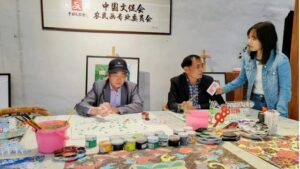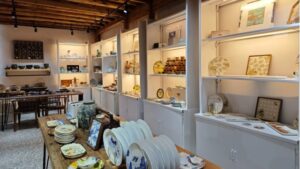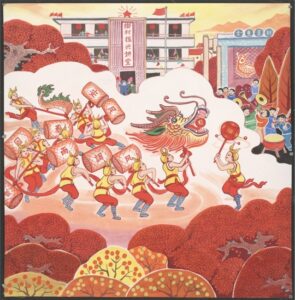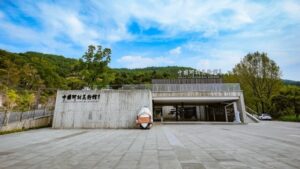Introduction
Yudong Village, located in Gouxi Township, Kecheng District, Quzhou City, Zhejiang Province, is renowned as China’s “Hometown of Farmer Paintings.” The local farmer painting tradition is celebrated for its distinctive rural charm, bold folk-art aesthetic, and contemporary expression. At the heart of this artistic movement is the Yudong Farmer Painting Society, which not only preserves and innovates this unique art form but also injects cultural vitality into rural revitalization. Below is an analysis of Yudong Farmer Paintings from the perspectives of its artists and artistic characteristics.
I. The Artist Community of Yudong Farmer Paintings
1. Dual Identity: Farmers and Artists
The primary creators in the Yudong Farmer Painting Society are local farmers who engage in agricultural or handicraft work during the day and immerse themselves in painting during their free time. This dual identity shapes their artistic vision—deeply rooted in the land, their works reflect a direct and intuitive perception of rural life, infused with a strong sense of authenticity and everyday realism.

Farmer painter Yu Chunliang is painting with villagers
2. Generational Transmission and Collective Creation
•The Older Generation: Artists like Zheng Genliang and Zheng Limin draw inspiration from traditional folk arts such as paper cutting, embroidery, and New Year paintings. Their early works depict farming scenes and festive customs, characterized by bold colors and straightforward compositions.
•The Younger Generation: With the advancement of rural revitalization policies, some young people have returned to their hometowns and joined the painting society. Having received formal artistic training, they experiment with modern techniques such as abstraction and digital art, expanding the themes to include environmental conservation and rural e-commerce.
•Collaborative Approach: Large-scale works such as murals and scroll paintings are often created collectively, showcasing the power of community and shared artistic vision.
3. Shifting Social Roles
Beyond being cultural custodians, these artists actively participate in rural development. Their work boosts rural tourism (e.g., the “Future Yudong Village” initiative) and has led to the development of cultural products like farmer painting-inspired scarves and ceramics. This marks a transformation from painting as a hobby to an integrated cultural economy.

Farmers paint cultural and creative products
II. Artistic Characteristics of Yudong Farmer Paintings
1. Themes and Subjects
•Rural Life: Farming activities (such as rice planting and grain drying), traditional festivals (like dragon dances and ancestor worship), and folk customs (weddings and local operas) are central motifs, preserving the cultural memory of western Zhejiang’s countryside.
•Contemporary Narratives: Recent works incorporate themes of rural revitalization, common prosperity, and ecological conservation. For example, paintings like Digital Countryside and Green Hills and Clear Waters reflect farmers’ perspectives on modern policies and social change.
•Mythology and Symbolism: Given Quzhou’s connection to Confucian heritage, some artworks incorporate Confucian values (e.g., Benevolence, Righteousness, Courtesy, Wisdom, and Trust) or local folklore (such as The Legend of White Snake), forming a unique cultural identity.

Farmer painter Zheng Genliang’s “Yudong Dragon Dance” peasant painting
2. Visual Style and Techniques
•Color Palette: The paintings favor highly saturated primary colors (bright red, vivid yellow, and lush green), creating strong visual contrast and conveying a sense of joy and prosperity.
•Composition: The artworks are often flat and decorative, with exaggerated figures (such as oversized heads and simplified limbs) and dense narrative details (where a single painting might depict sowing, harvesting, and drying crops simultaneously).
•Material Innovations: While traditionally using gouache and acrylic, recent explorations have combined farmer painting with bamboo weaving, ceramics, and digital media. Notable examples include Yudong’s 3D murals and the animated short film Yudong in Paintings.
3. Cultural Significance
•Modernizing Folk Art: Yudong Farmer Paintings challenge the stereotype of folk art being “rustic” by participating in national exhibitions and collaborating with art institutions like the China Academy of Art, thereby gaining broader artistic recognition.
•Strengthening Community Identity: Out of the village’s 800 residents, nearly one-third engage in painting. Art has become a communal bond, fostering a shared sense of belonging. For example, Panoramic View of Yudong Village offers an aerial perspective of the village, reinforcing collective identity and pride.

Exterior of China Rural Art Museum
In the end, I think this is a very good venue for choosing curation. It can not only showcase the scenery of the Jiangnan countryside, but also has a certain tourism and artistic foundation here.
References
1. China Federation of Literary and Art Circles. (2021). The 2nd National Farmer Painting Exhibition Opens in Yudong Village, Quzhou. Retrieved from
https://yangbo.cctv.com/2021/08/20/ARTI9wqFZ8HdZdaZMj5CqAw8210820.shtml
2.Zhejiang Daily. (2023). Yudong: From Farmer Painting to Cultural Economy. Retrieved from Zhejiang News Portal.
(浙江日报.《余东:从农民画到文化经济》,2023年)
3.Ministry of Culture and Tourism of the PRC. (2022). Case Study: Yudong Village’s Integration of Folk Art and Rural Revitalization.
中华人民共和国文化和旅游部:《案例研究:余东村如何将民间艺术融入乡村振兴》,2022年。
4.Zhang, L. (2018). The Contemporary Value of Chinese Farmer Paintings: A Case Study of Yudong Village, Zhejiang Province.
Journal of Folk Art Studies, 24(3), 45–52. (张丽,《中国农民画的当代表达:以浙江余东为例》,《民间美术研究》,2018年第3期)
5.Li, Y. (2020). From Pastoral to Participatory: The Evolution of Yudong Farmer Painting in the Digital Era.
Contemporary Art in China, 7(1), 66–74. (李颖,《从田园到参与:数字时代余东农民画的发展路径》,《中国当代艺术》)



25 February 2025 at 20:44
You have established a connection between the artwork and nature through the water lilies, which is a great entry point. I have seen your preliminary proposal for space planning, which shows a certain degree of innovation and feasibility. By adopting the model of ‘art intervening in the rural community’, you have cleverly connected the artist and the farmers, so that both of them can take on the role of cultural guardians together. However, from a curatorial point of view, the programme would be more convincing if it was supported by relevant theories. In addition, for the 10 checkpoints you mentioned, it is suggested to further explain the basis of their selection and functions in order to enhance the logic and practicality of the project. Looking forward to your subsequent more detailed and specific programme!